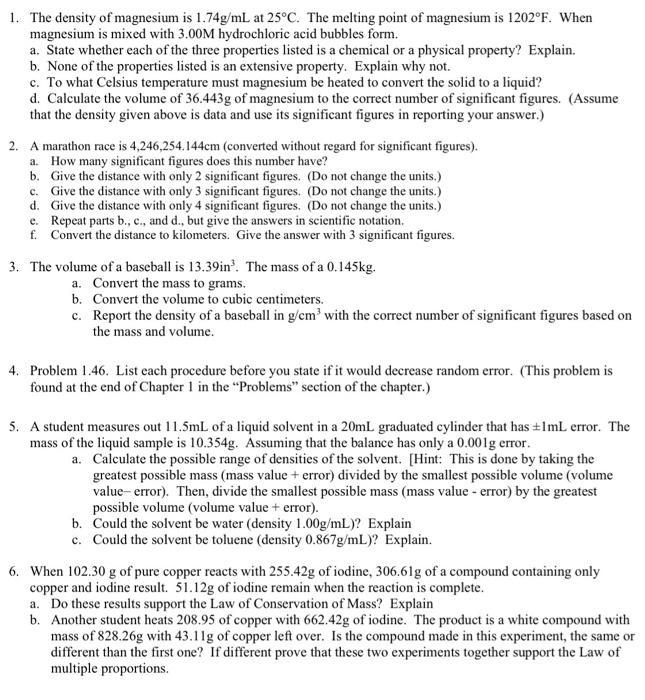1. The density of magnesium is 1.74g/mL at 25C. The melting point of magnesium is 1202F. When magnesium is mixed with 3.00M hydrochloric acid bubbles form. a. State whether each of the three properties listed is a chemical or a physical property? Explain. b. None of the properties listed is an extensive property. Explain why not. c. To what Celsius temperature must magnesium be heated to convert the solid to a liquid? d. Calculate the volume of 36.443g of magnesium to the correct number of significant figures. (Assume that the density given above is data and use its significant figures in reporting your answer.) 2. A marathon race is 4,246,254.144cm (converted without regard for significant figures). a. How many significant figures does this number have? b. Give the distance with only 2 significant figures. (Do not change the units.) c. Give the distance with only 3 significant figures. (Do not change the units.) d. Give the distance with only 4 significant figures. (Do not change the units.) e. Repeat parts b., c., and d., but give the answers in scientific notation. f. Convert the distance to kilometers. Give the answer with 3 significant figures. 3. The volume of a baseball is 13.39in3. The mass of a 0.145kg. a. Convert the mass to grams. b. Convert the volume to cubic centimeters. c. Report the density of a baseball in g/cm3 with the correct number of significant figures based on the mass and volume. 4. Problem 1.46. List each procedure before you state if it would decrease random error. (This problem is found at the end of Chapter 1 in the "Problems" section of the chapter.) 5. A student measures out 11.5mL of a liquid solvent in a 20mL graduated cylinder that has 1mL error. The mass of the liquid sample is 10.354g. Assuming that the balance has only a 0.001g error. a. Calculate the possible range of densities of the solvent. [Hint: This is done by taking the greatest possible mass (mass value + error) divided by the smallest possible volume (volume value-error). Then, divide the smallest possible mass (mass value - error) by the greatest possible volume (volume value + error). b. Could the solvent be water (density 1.00g/mL )? Explain c. Could the solvent be toluene (density 0.867g/mL )? Explain. 6. When 102.30g of pure copper reacts with 255.42g of iodine, 306.61g of a compound containing only copper and iodine result. 51.12g of iodine remain when the reaction is complete. a. Do these results support the Law of Conservation of Mass? Explain b. Another student heats 208.95 of copper with 662.42g of iodine. The product is a white compound with mass of 828.26g with 43.11g of copper left over. Is the compound made in this experiment, the same or different than the first one? If different prove that these two experiments together support the Law of multiple proportions







